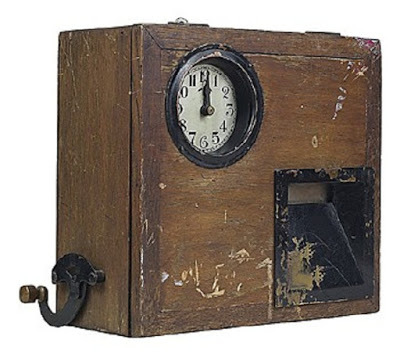Ahmed’s Clock, Banneker’s Clock, and the Racial Surveillance of Invention in America
 Ahmed’s Clock, Banneker’s Clock, and the Racial Surveillance of Invention in America by Britt Rusert | @b_rusert | special to NewBlackMan (in Exile)
Ahmed’s Clock, Banneker’s Clock, and the Racial Surveillance of Invention in America by Britt Rusert | @b_rusert | special to NewBlackMan (in Exile)While 14-year-old Ahmed Mohamed’s clock and his arrest link to current histories of Islamophobia in the United States as well as to the politics of inclusion in the STEM fields, there are other parts of this story that tap into a much longer history of race and science. Evolutionary biologist Richard Dawkins’ claim earlier this week that Ahmed’s clock was a “fraud” also reproduced a long history of the racial surveillance of invention itself in America.
In 1753, a young man of African descent named Benjamin Banneker also rose to prominence for building a clock: his creation was an impressive striking clock crafted out of wood. Banneker was a free man who gained regional and national recognition as an almanac-maker, astronomer, surveyor, and inventor in eighteenth-century America. He lived his entire life in Baltimore County, Maryland, where he farmed tobacco on a modest plot of land. Banneker constructed his clock when he was only 22 years old. In an age in which timepieces were still somewhat rare in the American colonies, visitors came from near and far to view a working clock constructed by a young man of color.
The story goes that Banneker entertained an almost constant stream of visitors in his home, people who wanted to see this homemade clock and were also curious about the black inventor who made it. But at the same time as Banneker was praised for his displays of intelligence and even genius, his inventions and scientific knowledge were also viewed with suspicion and disbelief by many white people. The barrage of visitors to Banneker’s home was thus also about confirming that this man, a black man, actually made the clock himself. And in this way, Banneker’s clock, like Ahmed’s clock, became a site of criminalization and racial surveillance.
One gets the sense that Banneker was forced to spend a lot of his time proving himself to whites: people from around the country sent him mathematical proofs to which they expected he would respond. After Thomas Jefferson wrote about the intellectual inferiorities of the African race in his book, Notes on the State of Virginia, Banneker sent a letter to the founding father, and then Secretary of State, in which he enclosed a manuscript copy of his own almanac for 1792. In Notes, Jefferson said that the jury was still out on the mental capacities of black people: he would need more proof to be convinced.
Banneker’s almanac stood as one such proof of the capabilities and capacities of the race. But Banneker was not just interested in proving the mental equality of Africans, he also used this as an opportunity to plead on behalf of his brethren, those men, women, and children who were unjustly held as slaves and captives in a supposedly freedom-loving republic.
When President Obama invited Ahmed to the White House last week, he also echoed Banneker’s story. Jefferson replied to Banneker’s letter with a curt, somewhat formulaic response, but one that nonetheless helped to legitimate Banneker’s scientific investigations and inventions on the national stage. He thanked Banneker for his letter and almanac and wrote, “No body wishes more than I do to see such proofs as you exhibit.” While Obama tweeted “Cool clock, Ahmed,” Jefferson’s language was ensconced in the formalities of Enlightenment rhetoric and letter writing. But there is much that connects these two pieces of correspondence, including the significance of a president, and in Jefferson’s case, a future president, recognizing the achievements and potential of inventors of color in the United States.
The use of Ahmed’s story to encourage young Muslims and other kids to get interested in engineering and other STEM fields is a laudable one, and one that will hopefully encourage future clock-makers, astronomers, and more. But this young man’s interest in inventing, experimenting, and even “tinkering” at home is also part of a vibrant history of race, science, and invention in the United States that exceeds both the classroom and presidential politics.
In the early nineteenth century, a handful of African Americans, from the revolutionary David Walker to the physician and pharmacist James McCune Smith, continued to carry on Benjamin Banneker’s legacy: they memorialized Banneker’s scientific achievements, wrote more critiques of Jefferson’s damaging theories of race, and produced sophisticated responses to an emerging racial science in the nineteenth century that abetted the slave system.
Largely restricted from universities, medical schools, and laboratories, they also worked on their own forms of autodidactic study and scientific experimentation, forms of invention and learning that were often explicitly linked to black freedom struggles against slavery in the South and anti-black racism in the North. These figures fought against the criminalization of African American experiments with science, but they also thought that science could be used to will a more equitable country into existence. In this way, we might say that Ahmed is continuing to carry that baton, linking scientific invention to the social movements of our own time.
+++
Britt Rusert is a Visiting Associate Research Scholar at Princeton University and an Assistant Professor of Afro-American Studies at the University of Massachusetts Amherst. She is completing a book titled “Fugitive Science: Empiricism and Freedom in Early African American Culture.” Follow her on Twitter: @b_rusert
Published on September 22, 2015 20:20
No comments have been added yet.
Mark Anthony Neal's Blog
- Mark Anthony Neal's profile
- 30 followers
Mark Anthony Neal isn't a Goodreads Author
(yet),
but they
do have a blog,
so here are some recent posts imported from
their feed.



